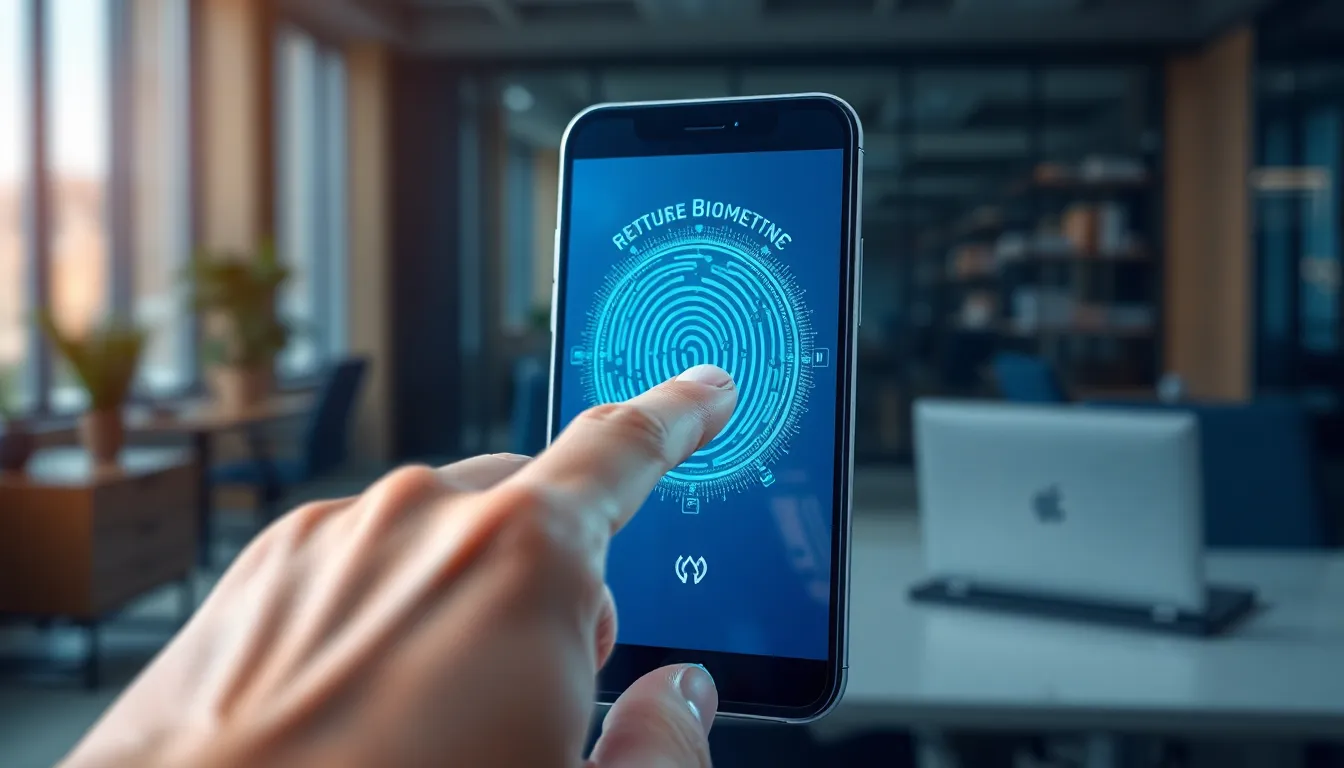In a world where remembering passwords feels like a Herculean task, biometric ID systems swoop in like a superhero, ready to save the day. Imagine unlocking your phone with just a glance or a simple touch of your finger. No more forgotten passwords or frantic attempts to recall that one special character you always forget. Biometric systems are here to make life easier, one fingerprint at a time.
Table of Contents
ToggleOverview of Biometric ID Systems
Biometric ID systems leverage unique physical or behavioral traits for identification and authentication. They often utilize fingerprints, facial recognition, iris patterns, and voice recognition. By relying on biological characteristics, these systems reduce the reliance on traditional methods like passwords.
Facial recognition technology identifies individuals based on facial features and has gained popularity in various sectors. Government agencies use it for surveillance and border control. Fingerprint scanning remains prevalent in mobile devices and secure applications, providing quick access and enhanced security.
Iris scanning involves analyzing the unique patterns in the colored part of the eye. This method boasts high accuracy and is frequently employed in high-security environments. Voice recognition systems analyze vocal patterns, making them suitable for phone-based authentication and smart assistants.
Organizations implementing biometric ID systems report higher levels of security and user satisfaction. Unlike passwords, biometric identifiers are difficult to replicate or share. They also streamline the user experience by allowing instant access without remembering complex alphanumeric codes.
While advantages abound, potential concerns include privacy issues and data security. Users may express discomfort regarding the storage and potential misuse of biometric data. Thus, ensuring robust security measures is vital to gaining public trust.
Biometric ID systems transform the identity verification landscape, offering innovative solutions that enhance convenience and security across multiple domains.
Types of Biometric ID Systems

Biometric ID systems encompass various technologies that utilize unique individual characteristics to verify identity. Each type offers distinct advantages in security and convenience.
Fingerprint Recognition
Fingerprint recognition remains one of the most widely adopted biometric methods. This technology identifies individuals through the unique patterns of ridges and valleys found on their fingertips. Many mobile devices and access control systems rely on fingerprint scanning for quick and secure user authentication. Notably, the accuracy in identifying users is exceptionally high, making it difficult for unauthorized individuals to gain access. Additionally, its integration into devices provides a seamless user experience.
Facial Recognition
Facial recognition technology analyzes facial features to identify individuals. This method captures a person’s image and compares it against stored data to confirm identity. Governments widely use this technology for surveillance and border control measures. In social media platforms, users benefit from automated tagging and photo organization features. Facial recognition’s ability to operate in real-time enhances its usability, fostering increased security across various applications.
Iris Recognition
Iris recognition is renowned for its exceptional accuracy and reliability. This technology scans the unique patterns of an individual’s iris, providing biometric identification with minimal risk of false positives. High-security environments, such as government facilities and financial institutions, frequently employ iris recognition due to its resistance to spoofing. Users find this method non-intrusive, allowing for quick identification without physical contact, which streamlines processes significantly.
Voice Recognition
Voice recognition technology uses an individual’s voice patterns for authentication. By analyzing characteristics such as pitch and tone, it accurately identifies users while minimizing the risk of impersonation. This method finds extensive applications in phone-based authentication and smart assistants, providing a convenient interaction experience. Voice recognition’s hands-free approach enhances usability, catering well to users in diverse environments.
Advantages of Biometric ID Systems
Biometric ID systems offer significant benefits, primarily focusing on security and user experience.
Enhanced Security
Enhanced security stands as a primary advantage of biometric ID systems. Unique traits, such as fingerprints or iris patterns, provide reliable identification that’s difficult to replicate or steal. According to a report by the International Journal of Information Security, biometric systems reduce the risk of unauthorized access. Traditional passwords often get compromised, but biometric methods ensure accuracy through their reliance on physical characteristics. Surveillance in various sectors, including government and finance, increasingly relies on these systems for their resilience against fraud. The ability to combine multiple biometric traits, like combining facial and voice recognition, further strengthens security layers. Overall, the innovation in biometric technology significantly bolsters protection against identity theft.
Convenience and Speed
Convenience and speed represent key reasons for adopting biometric ID systems. Users can quickly access devices or services without the hassle of remembering complex passwords. For instance, facial recognition allows instant unlocking of smartphones in seconds. Speedy authentication processes improve user satisfaction across platforms, especially in busy environments, like airports or offices. Many organizations leverage fingerprint scanners for efficient check-ins at events or secure access to facilities. Instant access fosters a seamless experience, minimizing delays and frustrations associated with traditional methods. As technology evolves, biometric systems continue to streamline user interactions, making everyday tasks more efficient.
Challenges and Limitations
Biometric ID systems face several challenges and limitations that impact their widespread adoption. Privacy concerns and technical limitations are among the most significant issues.
Privacy Concerns
Concerns about privacy frequently arise with biometric ID systems. Sensitive biometric data, such as fingerprints or facial images, requires stringent protection to prevent unauthorized access. Breaches of this data can lead to identity theft or misuse. Users may worry about how their information is stored, processed, and shared. Transparency regarding data usage is crucial in building trust with users. Regulations, such as the General Data Protection Regulation (GDPR), seek to address these challenges but implementation varies across regions. Consequently, the need for robust privacy measures is essential to alleviate public apprehensions.
Technical Limitations
Technical limitations also pose challenges for biometric ID systems. Environmental conditions can affect the accuracy of some biometric methods. For instance, facial recognition may struggle in low-light settings or when subjects wear masks. Fingerprint scanners may fail to read prints that are smudged or worn. Additionally, the technology relies heavily on quality sensors, which can vary significantly across devices. These disparities may lead to inconsistent user experiences. Moreover, the potential for false positives or negatives complicates reliability in critical applications. Emphasizing continual improvement of technology is necessary to overcome these hurdles.
Future Trends in Biometric ID Systems
Biometric ID systems continue to evolve, integrating advanced technologies and expanding their applications in various fields.
Integration with Other Technologies
Integration with artificial intelligence enhances biometric ID systems. Enhanced algorithms improve recognition accuracy and speed, particularly in dynamic environments. Cloud computing facilitates remote access and scalability for these systems. Smart devices increasingly incorporate biometric solutions, allowing for seamless user experiences across multiple platforms. Collaborative tools leverage biometric data for secure login and identity verification in corporate settings. Partnerships with cybersecurity firms promote the development of stronger encryption methods for biometric data storage.
Emerging Applications
Emerging applications show promising growth for biometric ID systems. Retailers utilize facial recognition for personalized shopping experiences, enhancing customer interactions. Health care providers adopt fingerprint and iris recognition for secure patient identification, minimizing fraud risks. Banks implement voice recognition technology for customer authentication during remote transactions, increasing security. Access control systems leverage biometric data for managing facility security in public and private sectors. Transportation hubs explore biometric solutions to streamline passenger verification and boarding processes, improving efficiency and security.
Biometric ID systems are reshaping the way individuals and organizations approach security and convenience. Their ability to provide quick and reliable access while minimizing the risks associated with traditional passwords highlights their growing importance. As technology continues to advance, the integration of artificial intelligence and cloud computing will further enhance the capabilities of these systems.
While challenges related to privacy and data security remain, ongoing improvements and regulatory measures will help build public trust. The future of biometric ID systems looks promising, with applications expanding across various sectors. Embracing these innovations will not only streamline user experiences but also contribute to a more secure digital landscape.




